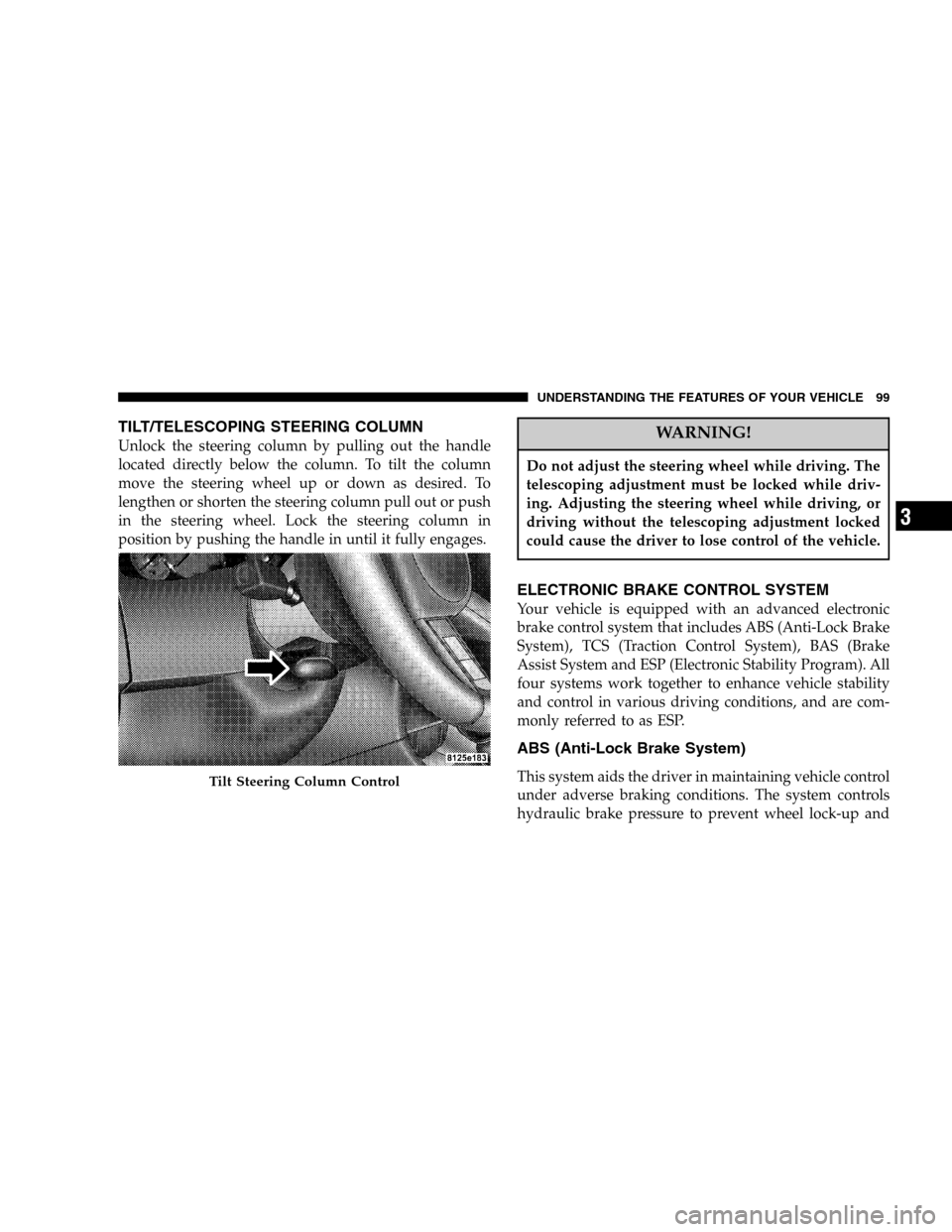DODGE MAGNUM SRT 2006 1.G Owners Manual
Manufacturer: DODGE, Model Year: 2006, Model line: MAGNUM SRT, Model: DODGE MAGNUM SRT 2006 1.GPages: 344, PDF Size: 10.88 MB
Page 91 of 344

TO OPEN AND CLOSE THE HOOD
Two latches must be released to open the hood. First, pull
the hood release lever located under the left side of the
instrument panel.
Next, move to the outside of the vehicle and push the
safety catch to the left. The safety catch is located under
the center front edge of the hood.Use the hood prop rod — if equipped to secure the hood
in the open position.
To prevent possible damage, do not slam the hood to
close it. Lower the hood until it is open approximately 6
inches (15 cm) and then drop it. This should secure both
latches. Never drive your vehicle unless the hood is fully
closed, with both latches engaged.
Hood Release Lever
Hood Safety Catch
UNDERSTANDING THE FEATURES OF YOUR VEHICLE 91
3
Page 92 of 344

WARNING!
If the hood is not fully latched, it could fly up when
the vehicle is moving and block your forward vision.
You could have a collision. Be sure all hood latches
are fully latched before driving.
LIGHTS
Overhead Console Map/Reading Lights
These lights are mounted between the sun visors on the
overhead console. Each light is turned ON by pressing
the lens. Press the lens a second time to turn the light
OFF. The lights also turn on when a door is opened or the
dimmer control is turned fully upward, past the second
detent.
Interior Lights
The interior lights come on when a door is opened.
The interior lights will automatically turn off 10 minutes
after the ignition switch is moved to the LOCK position
if they are switched on manually, or if a door is left open
to protect the battery. Turn the ignition switch ON, or
cycle the switchable lamp that was left on to restore the
interior light operation.
Overhead Console
92 UNDERSTANDING THE FEATURES OF YOUR VEHICLE
Page 93 of 344

Dimmer Control
The dimmer control is part of the
headlamp switch, and is located on the
left side of the instrument panel. With
the parking lights or headlights on,
rotating the dimmer control upward
will increase the brightness of the in-
strument panel lights.
Dome Light Position
Rotate the dimmer control completely upward to the
second detent to turn on the interior lights. The interior
lights will remain on when the dimmer control is in this
position.
Interior light Defeat (OFF)
Rotate the dimmer control to the extreme bottom “OFF”
position. The interior lights will remain off when the
doors are open.
Parade Mode (Daytime Brightness Feature)
Rotate the dimmer control upward to the first detent.
This feature brightens all text displays such as theodometer, Electronic Vehicle Information Center — if
equipped, and radio when the parking lights or head-
lights are on.
Headlight Switch
The headlight switch is located on the left side of the
instrument panel. This switch controls the operation of
the headlights, parking lights, instrument panel lights,
instrument panel light dimming, interior lights, and fog
lights.
Headlight Switch
UNDERSTANDING THE FEATURES OF YOUR VEHICLE 93
3
Page 94 of 344

Multi-Function Lever
The multi-function lever controls the operation of the
turn signals, headlight beam selection, and passing
lights. The lever is located on the left side of the steering
column.
Headlights, Parking Lights, Instrument Panel
Lights
Rotate the headlight switch clockwise to the first detent
for parking light and instrument panel light operation.
Turn to the second detent for headlight, park light and
instrument panel light operation.
Multi-Function Lever
Headlight Switch
94 UNDERSTANDING THE FEATURES OF YOUR VEHICLE
Page 95 of 344

Daytime Running Lights (Canada Only)
The high beam headlights will come on as Daytime
Running Lights whenever the ignition switch is on, the
headlights are off, and the parking brake is off. The
headlight switch must be used for normal night time
driving.
Lights-on Reminder
If the headlights or parking lights are on after the ignition
is turned OFF, a chime will sound to alert the driver
when the driver’s door is opened.
Headlight Time Delay
This feature provides the safety of headlight illumination
for 90 seconds (programmable) when leaving your ve-
hicle in an unlighted area.
To activate the delay feature, turn off the ignition switch
while the headlights are still on. Then turn off the
headlights within 45 seconds. The 90 second delay inter-
val begins when headlight switch is turned off. If the
headlights or park lights are turned back on or the
ignition switch is turned on, the delay will be cancelled.If the headlights are turned off before the ignition, they
will turn off in the normal manner.
NOTE:The lights must be turned off within 45 seconds
of turning the ignition off to activate this feature
The Headlamp delay time is programmable on vehicles
equipped with the Electronic Vehicle Information Center
(EVIC). Refer to “Delay Turning Headlamps Off” in the
Electronic Vehicle Information Center section for details.
Fog Lights — If Equipped
The front fog light switch is on the headlamp
switch below the dimmer control. To activate the
front fog lights, turn on the parking lights or the
low beam headlights and press the fog lamp switch.
NOTE:The fog lights will operate with the low beam
headlights, or parking lights on. However, selecting the
high beam headlights will turn off the fog lights.
Turn Signals
Move the Multi-Function Lever up or down and the
arrows on each side of the instrument cluster flash to
show proper operation of the front and rear turn signal
lights. You can signal a lane change by moving the lever
UNDERSTANDING THE FEATURES OF YOUR VEHICLE 95
3
Page 96 of 344

partially up or down without moving beyond the detent.
Releasing the lever at the detent will provide 3 flashes.
If either light has a very fast flash rate, check for a
defective outside light bulb. If an indicator fails to light
when the lever is moved, it would suggest that the fuse
or indicator bulb is defective or there may be a circuit
failure.
NOTE:The message “Turn Signal On” will appear in
the electronic vehicle information center (EVIC) — if
equipped, and a continuous chime will be heard when
the vehicle has been driven more than 1 mile (1.6 km)
with either turn signal on.
Highbeam/Lowbeam Select Switch
Push the Multi-Function Lever away from you to switch
the headlights to HIGH beam. Pull the Lever towards
you to switch the headlights back to LOW beam.
Flash to Pass
You can signal another vehicle with your headlights by
lightly pulling the Multi-Function Lever toward you.
This will cause the headlights to turn on at high beam
and remain on until the lever is released.
WINDSHIELD WIPERS AND WASHERS
Windshield Wiper Operation — Front
The front wipers and washers are operated by the
multi-function lever. The lever is located on the
left side of the steering column. Rotate the end of
the control lever to select the desired wiper speed.
Intermittent Wiper System
Use the intermittent wiper when weather conditions
make a single wiping cycle, with a variable pause be-
tween cycles, desirable. Rotate the end of the lever to the
Windshield Wiper/Washer
96 UNDERSTANDING THE FEATURES OF YOUR VEHICLE
Page 97 of 344

first detent position, then turn the end of the lever to
select the desired delay interval. There are 6 possible
delay wiper positions. The delay can be regulated from a
maximum of approximately 23 seconds between cycles,
to a cycle every second.
Mist Feature
Push the wiper lever in to activate a single wipe to clear
off road mist or spray from a passing vehicle. As long as
the lever is pushed in, the wipers will continue to
operate.
Rotate the end of the lever to the second detent for Low
speed wiper operation, or to the third detent for High
speed operation.
Windshield Wiper Operation — Rear
The rear wiper and washer is operated by the rear wiper
switch. The switch is located near the top center of the
instrument panel. The rear wiper and washer switch
provides intermittent wiper operation (not adjustable) as
well as rear washer operation. An indicator in the rear
wiper switch is illuminated when the rear wiper is on.To use the rear wiper, push the left side of the windshield
wiper/washer switch in and release. The rear wiper
system is intermittent, and is not adjustable. The delay is
approximately 8 to 9 seconds between cycles.
Windshield Washers
Front Windshield Washer
To use the front washer, push the lever in and hold while
spray is desired. If the lever is released while in the delay
Rear Wiper/Washer Switch
UNDERSTANDING THE FEATURES OF YOUR VEHICLE 97
3
Page 98 of 344

range, the wiper will operate for two wipe cycles after the
lever is released, and then resume the intermittent inter-
val previously selected.
If the lever is pushed while in the OFF position, the
wipers will operate for two wipe cycles, then turn OFF.
Rear Windshield Washer
To use the rear washer, push the right side of the
windshield wiper/washer switch in and hold while
spray is desired (maximum spray of 10 seconds). The
wiper operates for 2 wipe cycles after the switch is
released.
Adding Washer Fluid
The fluid reservoir for the windshield washers and the
rear window washer is shared. It is located in the front of
the engine compartment on the passenger side and
should be checked for fluid level at regular intervals. Fill
the reservoir with windshield washer solvent (not radia-
tor antifreeze) and operate the system for a few seconds
to flush out the residual water.The washer fluid reservoir will hold a full gallon of fluid
when “Low Washer Fluid” appears in the instrument
cluster.
Windshield Washer Fluid Reservoir
98 UNDERSTANDING THE FEATURES OF YOUR VEHICLE
Page 99 of 344

TILT/TELESCOPING STEERING COLUMN
Unlock the steering column by pulling out the handle
located directly below the column. To tilt the column
move the steering wheel up or down as desired. To
lengthen or shorten the steering column pull out or push
in the steering wheel. Lock the steering column in
position by pushing the handle in until it fully engages.WARNING!
Do not adjust the steering wheel while driving. The
telescoping adjustment must be locked while driv-
ing. Adjusting the steering wheel while driving, or
driving without the telescoping adjustment locked
could cause the driver to lose control of the vehicle.
ELECTRONIC BRAKE CONTROL SYSTEM
Your vehicle is equipped with an advanced electronic
brake control system that includes ABS (Anti-Lock Brake
System), TCS (Traction Control System), BAS (Brake
Assist System and ESP (Electronic Stability Program). All
four systems work together to enhance vehicle stability
and control in various driving conditions, and are com-
monly referred to as ESP.
ABS (Anti-Lock Brake System)
This system aids the driver in maintaining vehicle control
under adverse braking conditions. The system controls
hydraulic brake pressure to prevent wheel lock-up andTilt Steering Column Control
UNDERSTANDING THE FEATURES OF YOUR VEHICLE 99
3
Page 100 of 344

help avoid skidding on slippery surfaces during braking.
Refer to “Anti-Lock Brake System” in Section 5 of this
manual for more information about ABS.
TCS (Traction Control System)
This system monitors the amount of wheel spin of each of
the driven wheels. If wheel spin is detected, brake
pressure is applied to the slipping wheel(s) and engine
power is reduced to provide enhanced acceleration and
stability.
BAS (Brake Assist System)
The BAS is designed to optimize the vehicle’s braking
capability during emergency braking maneuvers. The
system applies optimum pressure to the brakes in emer-
gency braking conditions. This can help reduce braking
distances. The BAS complements the antilock brake sys-
tem (ABS). Applying the brakes very quickly results in
the best BAS assistance. To receive the benefit of the
system, you must apply continuous braking pressure
during the stopping sequence. Do not reduce brake pedal
pressure.
Once the brake pedal is released, the BAS is deactivated.
ESP (Electronic Stability Program)
This system enhances directional control and stability of
the vehicle under various driving conditions. ESP cor-
rects for over/under steering of the vehicle by applying
the brake of the appropriate wheel to assist in counter-
acting the over/under steer condition. Engine power
may also be reduced to help the vehicle maintain the
desired path.
ESP uses sensors in the vehicle to determine the vehicle
path intended by the driver and compares it to the actual
path of the vehicle. When the actual path does not match
the intended path, ESP applies the brake of the appropri-
ate wheel to assist in counteracting the oversteer or
understeer condition.
•Oversteer - when the vehicle is turning more than
appropriate for the steering wheel position.
•Understeer - when the vehicle is turning less than
appropriate for the steering wheel position.
100 UNDERSTANDING THE FEATURES OF YOUR VEHICLE